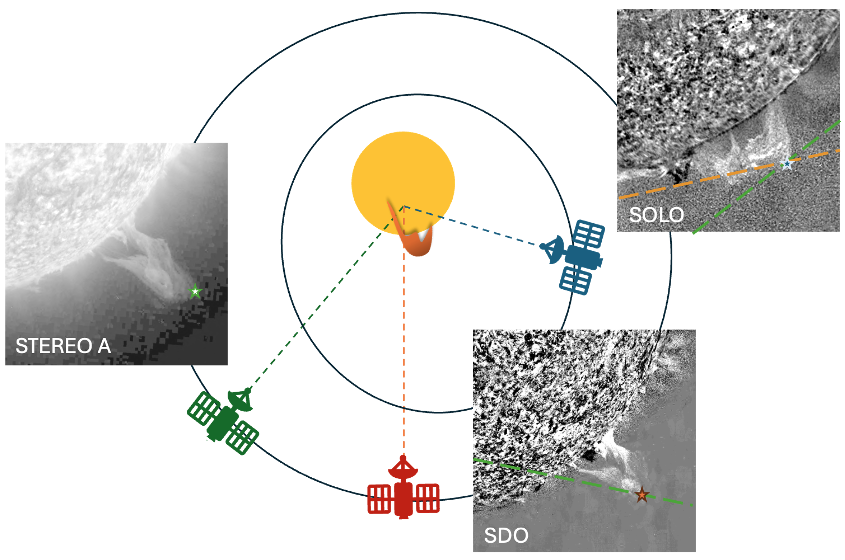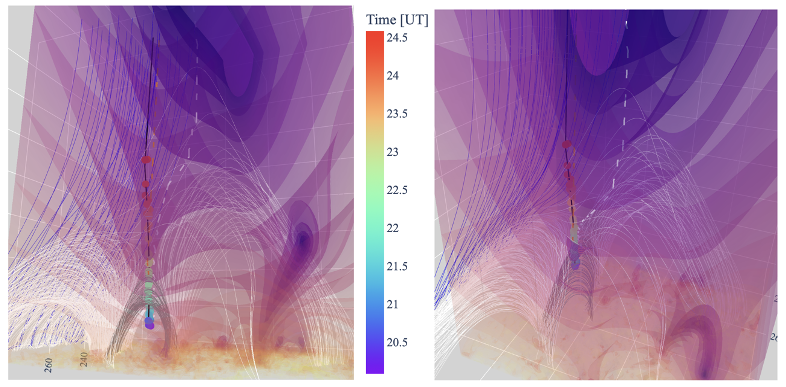Science Nugget: Analysis of Solar Eruptions Deflecting in the Low Corona - Solar Orbiter
Analysis of Solar Eruptions Deflecting in the Low Corona
(Solar Orbiter Nugget #54 by A. Sahade1, A. Vourlidas2 and C. Mac Cormack3)
1. Introduction
Coronal mass ejections (CMEs) are the drivers of the most powerful geomagnetic storms and a major concern in space weather. A reliable prediction of an eruption and its subsequent trajectory is crucial to assess its potential threat to satellites, communication networks, or other systems. Multi-point observations, including Solar Orbiter data, have allowed the identification of CME source regions and the calculation of their 3D trajectories. We proposed a new method, based on the ambient magnetic field, to understand and predict the direction of propagation of eruptive events.
Our results suggest that the topology of the surrounding magnetic field is a dominant factor driving deflections in the low corona, making this method promising for early prediction of CME trajectories.
2. Computing the trajectories from 3 viewpoints
Many CMEs are related with the eruption of a filament/prominence in the low corona. This kind of eruptions is useful to follow the evolution and trajectory of the CME from its origin. Studying the trajectory evolution of eruptions requires 3D reconstruction techniques that allow us to track corresponding features observed from different points of view (POVs). The tie-pointing technique is very effective for tracking eruptions because it relies on identifying the same feature in different projections. This technique calculates the 3D coordinates of a feature by matching corresponding pixels in images taken, typically, from two different viewpoints.

Figure 1: Scheme of the orbital configuration of a prominence observed simultaneously by STEREO A, SDO and Solar Orbiter. The three-dimensional position of the prominence apex can be derived from the 2D coordinates of corresponding features in the different points of view (stars in each subpanel).
Solar Orbiter now provides a third viewpoint in the heliosphere to observe, among other things, filament eruptions. To take advantage of this, we have developed a 3D reconstruction technique that combines images from three different observatories. Figure 1 shows a schematic representation of a prominence projected by STEREO A, SDO and SOLO POV and the corresponding position of a pixel (start markers) over the different images. Dashed lines indicate the epipolar line (green for STEREO A, orange for SDO) of the selected pixel. SCC_MEASURE3 [1] uses images from 3 different viewpoints to improve the 3D reconstruction.
3. Deflection and magnetic ambient

Figure 2: Example of the ambient magnetic (field lines and contours of magnetic energy) and trajectory (tracked color dots and black curve showing the fitting) of an eruptive prominence on 21 March 2021 from different views, an interactive view is available here.
It is well known that the magnetic fields surrounding the source region can alter the direction of propagation, deflecting the trajectory of CMEs, especially in their early evolution (see e.g. [2], and references therein). However, the main factor of this influence has been attributed to either the magnetic energy gradient or the topology of the magnetic field lines.
In our study [3], we explored a novel method for estimating CME deflection when the source region and background magnetic field are known. This approach calculates two magnetic paths: the 'gradient path,' which represents the trajectory of an eruption solely influenced by the magnetic energy gradient, and the 'topological path,' which corresponds to the trajectory of an eruption guided by the magnetic field lines. These paths help determine whether the eruption's deflection is mainly due to magnetic pressure or the configuration of the magnetic field lines. To assess this, we compared the magnetic paths originating from the source region with the actual eruption trajectory derived from tracking.
4. Conclusions

Figure 3: Example of the trajectory (color dots and black curve) compared with the topological path (orange dashed line) and gradient path (green dashed line) for the event on 31 December 2021. The white (blue) lines are closed (open) magnetic field lines near the source region.
We found that the "gradient path" is generally very different from the actual trajectory, indicating that deflections (at 2.5 Rs) can be overestimated by up to ∼20°. The "topological path", on the other hand, better describe the eruptive paths of the events studied. These results suggest rather strongly that the topology of the surrounding magnetic field may be the dominant driver for the deflection of eruptions in the low corona. Of course, the two quantities are related, since we are considering a potential magnetic field, but the topology takes into account not only the strength of the magnetic field, but also its connectivity and "shape". Clearly, the latter are important factors to consider in the evolution of CMEs.
In summary, we presented a new method for interpreting the very early path of an eruption. The topological and gradient methods rely only on the source-region location and the 3D structure of the background coronal field. CME measurements are not required. These properties make the topological method a potentially powerful addition to the present forecasting infrastructure.
Affiliations
(1) NASA Goddard Space Flight Center, MD, USA
(2) The Johns Hopkins University Applied Physics Laboratory, MD, USA
(3) The Catholic University of America, DC, USA
Acknowledgements
A.S. was supported by an appointment to the NASA Postdoctoral Program at the NASA Goddard Space Flight Center, administered by Oak Ridge Associated Universities under contract with NASA. A.V. was supported by NASA grant 80NSSC21K1860. C.M. was supported by an appointment to the Solar Orbiter Heliospheric Imager (SoloHI). The SoloHI instrument was designed, built, and is now operated by the US Naval Research Laboratory with the support of the NASA Heliophysics Division, Solar Orbiter Collaboration Office, under DPR NNG09EK11I. We acknowledge the use of SolO/EUI, SoloHI, SDO/AIA, SOHO/LASCO, and STEREO/EUVI, COR2 data.
References
[1] Sahade A. (2024) scc_measure 3 v1 Zenodo, doi:10.5281/zenodo.13951841
[2] Cécere M., Costa A., Cremades H. and Stenborg G. (2023) FrASS 10:1260432
[3] Sahade A., Vourlidas A. and Mac Cormack C. (2025) ApJ 978(1):41
Nuggets archive
2025
19/03/2025: Radial dependence of solar energetic particle peak fluxes and fluences
12/03/2025: Analysis of solar eruptions deflecting in the low corona
05/03/2025: Propagation of particles inside a magnetic cloud: Solar Orbiter insights
19/02/2025: Rotation motions and signatures of the Alfvén waves in a fan-spine topology
12/02/2025: 'Sun'day everyday: 2 years of Solar Orbiter science nuggets that shed light on some of our star's mysteries
22/01/2025: Velocity field in the solar granulation from two-vantage points
15/01/2025: First joint X-ray solar microflare observations with NuSTAR and Solar Orbiter/STIX
2024
18/12/2024: Shocks in tandem : Solar Orbiter observes a fully formed forward-reverse shock pair in the inner heliosphere
11/12/2024: High-energy insights from an escaping coronal mass ejection
04/12/2024: Investigation of Venus plasma tail using the Solar Orbiter, Parker Solar Probe and Bepi Colombo flybys
27/11/2024: Testing the Flux Expansion Factor – Solar Wind Speed Relation with Solar Orbiter data
20/11/2024:The role of small scale EUV brightenings in the quiet Sun coronal heating
13/11/2024: Improved Insights from the Suprathermal Ion Spectrograph on Solar Orbiter
30/10/2024: Temporally resolved Type III solar radio bursts in the frequency range 3-13 MHz
23/10/2024: Resolving proton and alpha beams for improved understanding of plasma kinetics: SWA-PAS observations
25/09/2024: All microflares that accelerate electrons to high-energies are rooted in sunspots
25/09/2024: Connecting Solar Orbiter and L1 measurements of mesoscale solar wind structures to their coronal source using the Adapt-WSA model
18/09/2024: Modelling the global structure of a coronal mass ejection observed by Solar Orbiter and Parker Solar Probe
28/08/2024: Coordinated observations with the Swedish 1m Solar Telescope and Solar Orbiter
21/08/2024: Multi-source connectivity drives heliospheric solar wind variability
14/08/2024: Composition Mosaics from March 2022
19/06/2024: Coordinated Coronal and Heliospheric Observations During the 2024 Total Solar Eclipse
22/05/2024: Real time space weather prediction with Solar Orbiter
15/05/2024: Hard X ray and microwave pulsations: a signature of the flare energy release process
01/02/2024: Relativistic electrons accelerated by an interplanetary shock wave
11/01/2024: Modelling Two Consecutive Energetic Storm Particle Events observed by Solar Orbiter
2023
14/12/2023: Understanding STIX hard X-ray source motions using field extrapolations
16/11/2023: EUI data reveal a "steady" mode of coronal heating
09/11/2023: A new solution to the ambiguity problem
02/11/2023: Solar Orbiter and Parker Solar Probe jointly take a step forward in understanding coronal heating
25/10/2023: Observations of mini coronal dimmings caused by small-scale eruptions in the quiet Sun
18/10/2023: Fleeting small-scale surface magnetic fields build the quiet-Sun corona
27/09/2023: Solar Orbiter reveals non-field-aligned solar wind proton beams and its role in wave growth activities
20/09/2023: Polarisation of decayless kink oscillations of solar coronal loops
23/08/2023: A sharp EUI and SPICE look into the EUV variability and fine-scale structure associated with coronal rain
02/08/2023: Solar Flare Hard Xrays from the anchor points of an eruptive filament
28/06/2023: 3He-rich solar energetic particle events observed close to the Sun on Solar Orbiter
14/06/2023: Observational Evidence of S-web Source of Slow Solar Wind
31/05/2023: An interesting interplanetary shock
24/05/2023: High-resolution imaging of coronal mass ejections from SoloHI
17/05/2023: Direct assessment of far-side helioseismology using SO/PHI magnetograms
10/05/2023: Measuring the nascent solar wind outflow velocities via the doppler dimming technique
26/04/2023: Imaging and spectroscopic observations of EUV brightenings using SPICE and EUI on board Solar Orbiter
19/04/2023: Hot X-ray onset observations in solar flares with Solar Orbiter/STIX
12/04/2023: Multi-scale structure and composition of ICME prominence material from the Solar Wind Analyser suite
22/03/2023: Langmuir waves associated with magnetic holes in the solar wind
15/03/2023: Radial dependence of the peak intensity of solar energetic electron events in the inner heliosphere
08/03/2023: New insights about EUV brightenings in the quiet sun corona from the Extreme Ultraviolet Imager








































 Sign in
Sign in
 Science & Technology
Science & Technology